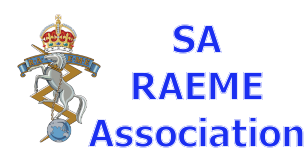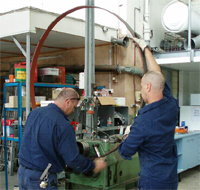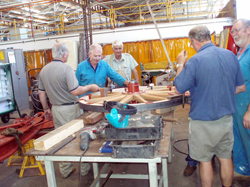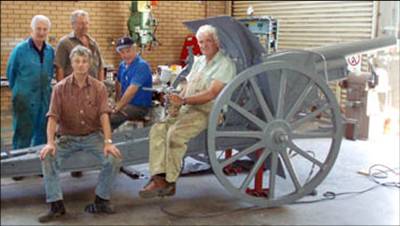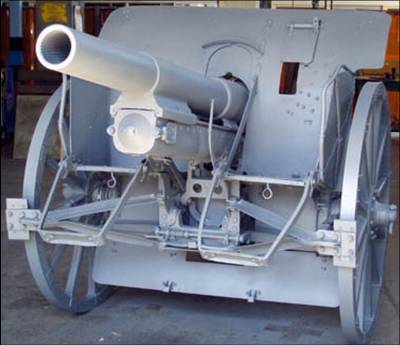A brief history of WW1 German war trophies
(Ref: “War Trophies from the First World War 1914 – 1918”
by Maj Bill Billett Kangaroo Press 1999
After World War 1 the War Trophies committee, a sub committee of a British War Office committee was established “to control the distribution of all the trophies captured by the Imperial Armies.” There were many disagreements and negotiations about who should have claim to these trophies but in July 1918 it was decided that AIF units who claimed their trophies could have them “if they could substantiate their claim and if they were not serviceable or required for conversion”. Subsequently it was reported in the newspapers of the day that 300 Artillery pieces, 3000 machine guns, trench mortars, many horse drawn vehicles and motor vehicles would be bought from England to Australia where distribution would be made to the many claimants in the cities and townships around the country.
On March 29th 1919 some of the trophies left England in an Australian government ship the SS Bulla. By August that year the last of the trophies had left England.
In South Australia, the War Trophy committee consisting of a Senate Rep Sen. H.S.Newland; a Government rep, A.E.Simpson; an Opposition rep, N.Meakin esq. and an AIF rep, Maj T.A.Brinkworth and the Director of the Australian War Museum. Evidently there were three distributions, the first based “on the claim of the AIF units that had captured the guns.” These AIF units later became the basis of CMF units. The second distribution “were allotted to towns across Australia” and a third distribution made from trophies not accepted by some towns plus some other trophies which became available later on.
By December 1920 Sth Australia had been allocated “35 Guns, 364 Machine Guns and 22 Trench Mortars.” Adelaide City received 8, 16 and 4 respectively of this distribution. Evidently Towns were asked to accept some conditions for being able to receive a trophy. “These pre-conditions were:
“• that three trustees, including a member of the AIF be appointed to act on behalf of the town in this matter;
• that these trustees forward to the Committee a signed agreement:
• to arrange for the trophy to be permanently housed in a public park, garden or building within the town; and for its preservation and safe custody;
• to arrange a simple ceremony at which it will be formally taken over;
• to bear expenses connected with its movement and installation after arrival at the nearest railway station.”
THE MOONTA WW1 WAR TROPHY
One of these trophies a 105 mm German Howitzer believed to have been captured by A Corps (unknown location) with the serial number 20623 was presented to the Town of Moonta in June 1921. This gun which has recently been properly identified by Lt Col HerbertJager in Leipzig Germany, author of the book “German Artillery of WW1.
Col Jager has been in regular correspondence with Robin Maslen the project co-ordinator. He has been invaluable in also providing technical sketches, drawings and specifications of these guns and their ammunition. He was delighted to hear about our restoration work.
Col. Jager, is a retired officer in the German Ordnance Corps and a past vice President of the Artillery Study Group which is attached to the School of Artillery. His job was to answer all enquiries concerning artillery. He has advised that this gun, manufactured in 1918 is a rather rare one having been manufactured not by Rheinmetal or Krupp but by an unknown factory with the initials “RWF” stamped on the breech block. (R could be the name of the owner, W for “Werke” (Factories) and “F for the place. Krupp probably outsourced some of their work. He has identified it with measurements provided to him as a 10.5 cm leichte Feldhaubitze Krupp L/20.
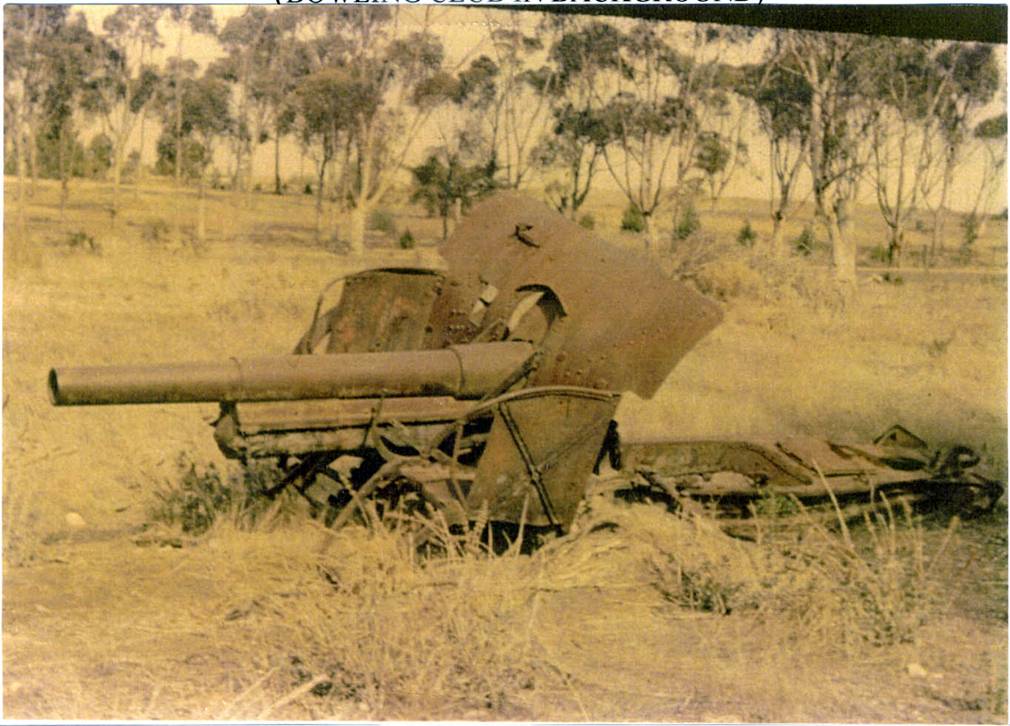 The gun had several locations in Moonta ending up in a paddock near the Moonta mines. When a local Pt Hughes resident and ex member of the corps of the Royal Australian Electrical & Mechanical Engineers (RAEME) Bruce Watson saw the gun rusting away he enlisted the help of the RAEME workshops in Warradale Adelaide to recover the gun and undertake its restoration.
The gun had several locations in Moonta ending up in a paddock near the Moonta mines. When a local Pt Hughes resident and ex member of the corps of the Royal Australian Electrical & Mechanical Engineers (RAEME) Bruce Watson saw the gun rusting away he enlisted the help of the RAEME workshops in Warradale Adelaide to recover the gun and undertake its restoration.
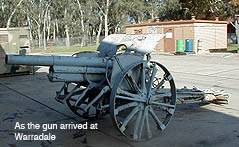 In February 2004 the gun was removed to Warradale. It remained there for about a year, untouched, as the workshops had a different set of priorities for their Reserve and an expected apprenticeship scheme failed to materialise. So the AEME/RAEME association came to the rescue and under the supervision of Robin Maslen (RAEME Capt Retd) a work party of volunteers started on the 23rd May 2005 to completely strip the gun in preparation for restoration and repair to make all parts moveable. We decided to make as many assemblies as possible work as the gun was to be housed in a protective specially constructed building at Moonta.
In February 2004 the gun was removed to Warradale. It remained there for about a year, untouched, as the workshops had a different set of priorities for their Reserve and an expected apprenticeship scheme failed to materialise. So the AEME/RAEME association came to the rescue and under the supervision of Robin Maslen (RAEME Capt Retd) a work party of volunteers started on the 23rd May 2005 to completely strip the gun in preparation for restoration and repair to make all parts moveable. We decided to make as many assemblies as possible work as the gun was to be housed in a protective specially constructed building at Moonta.
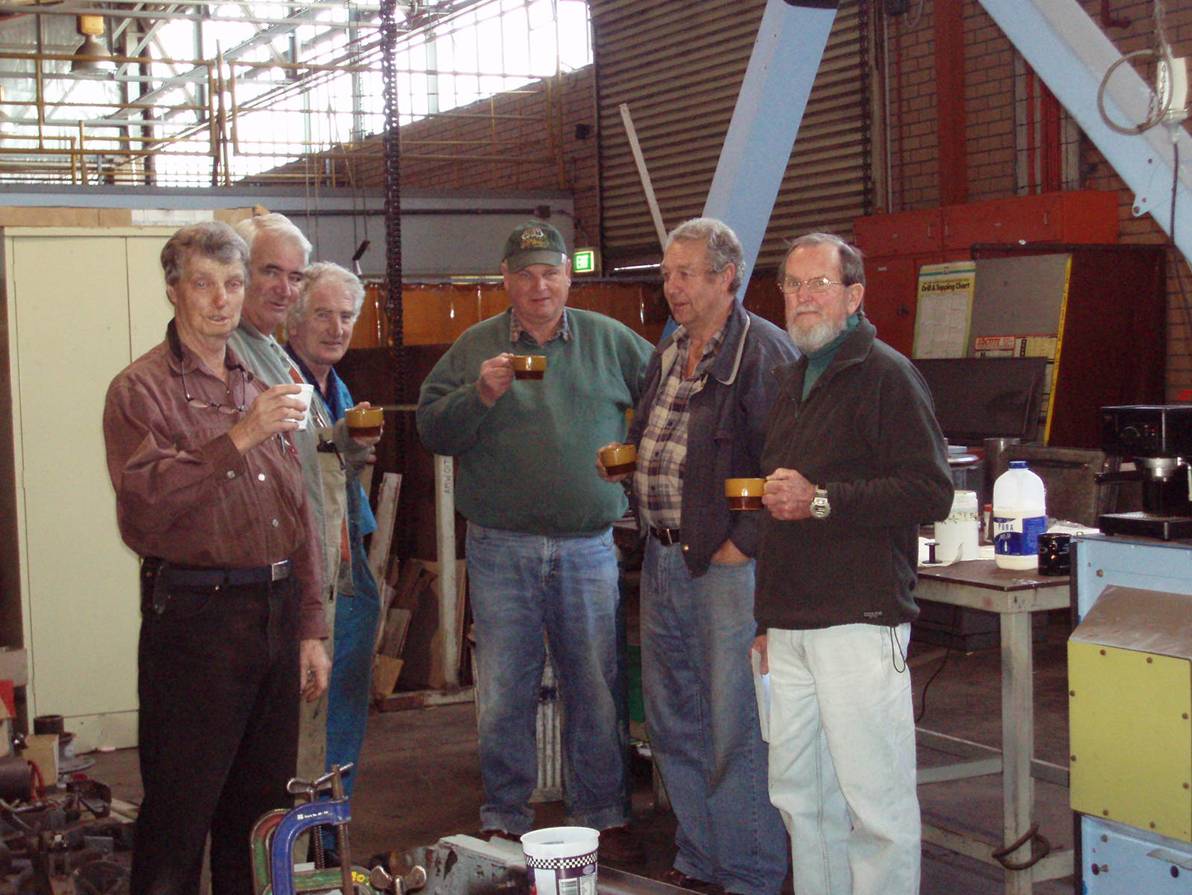 This work party meets every Monday with the permission of the CO of the Warradale area and the assistance of the 107 Fd workshop regular army personnel. The group has grown as work became known and those who have been involved are:- some ex RAEME Viet Vets, Graham Janz, Keith Tainsh, John Zander & Ray Nicholls, three ex RAEME Natios, Rex Doyle, Don Sutherland & Robin Maslen, ex 107 CMF John Howard, Don Sutherland, two volunteers from the Army Museum at Keswick, Ex Arty guy, John Fuller, and a Civvy, Eddie Olorenshaw plus ex 3 RAR Pte Ray Nicholls.
This work party meets every Monday with the permission of the CO of the Warradale area and the assistance of the 107 Fd workshop regular army personnel. The group has grown as work became known and those who have been involved are:- some ex RAEME Viet Vets, Graham Janz, Keith Tainsh, John Zander & Ray Nicholls, three ex RAEME Natios, Rex Doyle, Don Sutherland & Robin Maslen, ex 107 CMF John Howard, Don Sutherland, two volunteers from the Army Museum at Keswick, Ex Arty guy, John Fuller, and a Civvy, Eddie Olorenshaw plus ex 3 RAR Pte Ray Nicholls.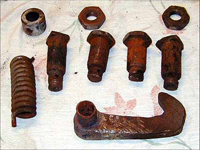 Many of the parts were heavily rusted and expanded and so lots of banging, heating cursing and grunting kept the workshop personnel awake on each Monday. A 20-ton press finally helped to strip almost everything. It was decided to leave the Recuperator alone on the advice of Col Jager as without the correct tools, and probably even with them; we might have wiped out the office block.
Many of the parts were heavily rusted and expanded and so lots of banging, heating cursing and grunting kept the workshop personnel awake on each Monday. A 20-ton press finally helped to strip almost everything. It was decided to leave the Recuperator alone on the advice of Col Jager as without the correct tools, and probably even with them; we might have wiped out the office block.
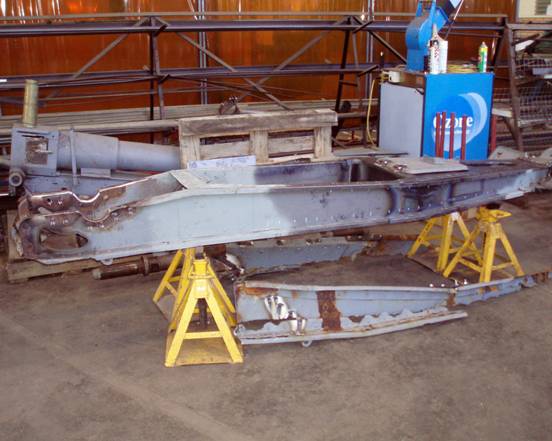 In March 2006 the new trails, manufactured courtesy of Lt Craig Williams from 107 Fd Wksp Reserve at his Metal fabrication factory at Pt Adelaide arrived at the workshop. A local Adelaide wheelwright, Peter Foster is to make two new wheels in the traditional method by using specially purchased and imported hardwood for the spokes and felloes.
In March 2006 the new trails, manufactured courtesy of Lt Craig Williams from 107 Fd Wksp Reserve at his Metal fabrication factory at Pt Adelaide arrived at the workshop. A local Adelaide wheelwright, Peter Foster is to make two new wheels in the traditional method by using specially purchased and imported hardwood for the spokes and felloes.
The new steel tyres will be heated and dropped over the spokes and felloes. The gun unfortunately has two different size steel tyres. One is 80mm wide the other 160mm. This means that the hubs are slightly different so a search went on around Australian Army museums and SA RSLs to see if another hub to suit the 80mm wheel could be located to make the wheelwright’s task easier. Probably this gun was damaged in battle and so a wheel off of a larger gun was used to repair the damage.
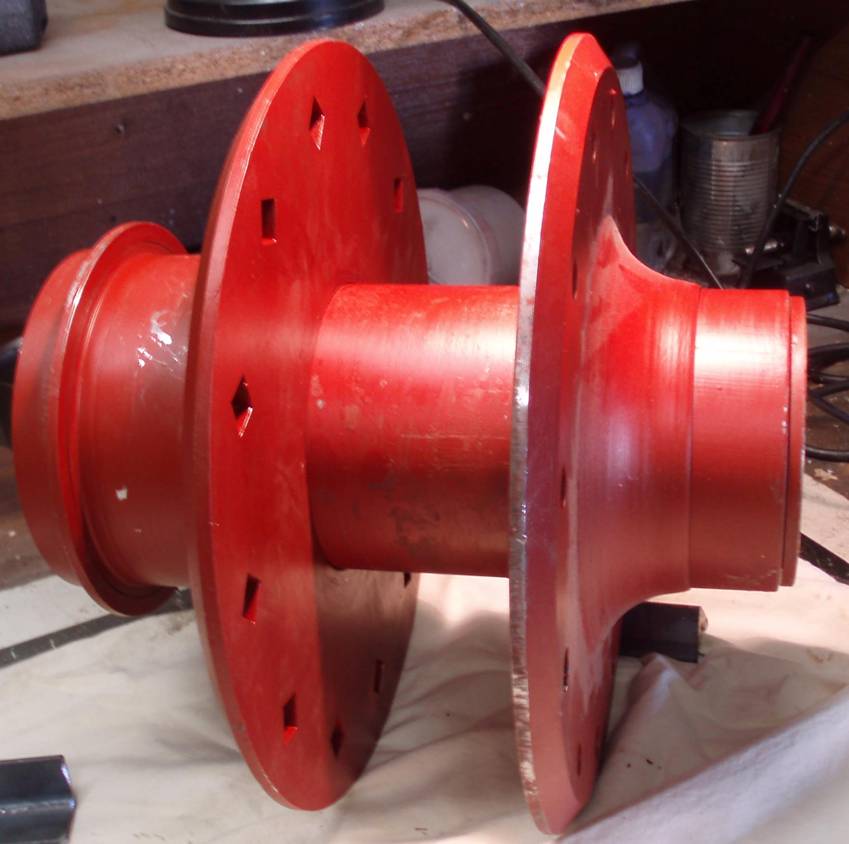 With no luck finding one, a new hub was now manufactured in the lathe at the workshop.
With no luck finding one, a new hub was now manufactured in the lathe at the workshop.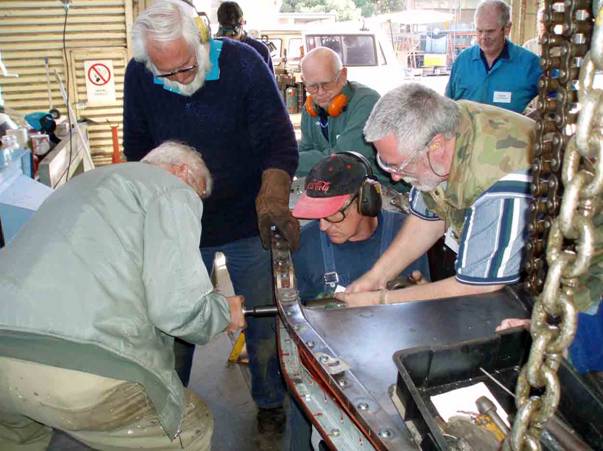 Another volunteer John Lyas had been recruited to oversee the riveting of the gun and with the financial help of the TAFE College at Panorama and Manager Chris Dunbar this event happened on the 21st June 06 and 18 volunteers made up the class under John’s instruction. Although the riveting was made to look easy by John and his two helpers the project group had to get him back later to refresh our training skills. John is a volunteer with the Pichi Richi railway and also a riveter. The Snaps were lent to us by the Pitchi Richi Railway group and John had lined up the local Panorama TAFE college to teach us all how to do the riveting with the college paying for this unique study group into some of the old trade skills. Hopefully this gun will look almost like new when finished.
Another volunteer John Lyas had been recruited to oversee the riveting of the gun and with the financial help of the TAFE College at Panorama and Manager Chris Dunbar this event happened on the 21st June 06 and 18 volunteers made up the class under John’s instruction. Although the riveting was made to look easy by John and his two helpers the project group had to get him back later to refresh our training skills. John is a volunteer with the Pichi Richi railway and also a riveter. The Snaps were lent to us by the Pitchi Richi Railway group and John had lined up the local Panorama TAFE college to teach us all how to do the riveting with the college paying for this unique study group into some of the old trade skills. Hopefully this gun will look almost like new when finished.
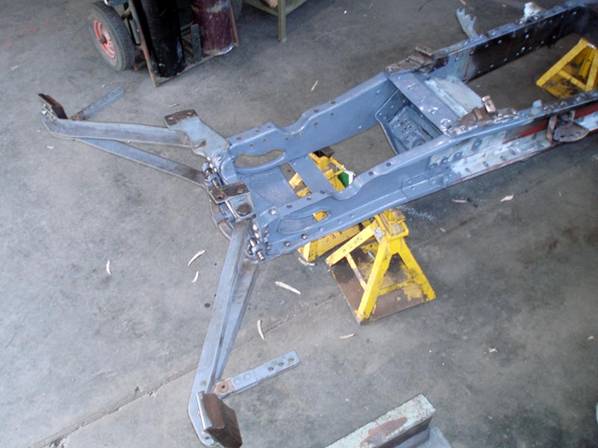 With the Trails now riveted it was time to start trying to fit all the pieces back together and much fun was had in trying to remember what went where.
With the Trails now riveted it was time to start trying to fit all the pieces back together and much fun was had in trying to remember what went where.
In hindsight, although many pictures were taken as we stripped bits, not sufficient or in the right angle of the shots to make it that easy to restore it all, Fortunately with quick trips to the guns at the Keswick museum and searching the Internet we were able to slowly complete its reassembly. However we had to manufacture a whole variety of small and large bits that were too damaged or missing altogether and at this time 6th October we have only one assembly left to make. That of the breech block handle and mechanism to make the block slide in and out. We have made new brake cables and pulleys, a new rear handle for moving the gun numerous nuts, bolts and various size pins, ball race pressure pads for the traversing mechanism, hold down catches for the container lids, one new hub and lots of metal U pieces for fixing the spoke to the felloes, wooden handles and seats.
However we had to manufacture a whole variety of small and large bits that were too damaged or missing altogether and at this time 6th October we have only one assembly left to make. That of the breech block handle and mechanism to make the block slide in and out. We have made new brake cables and pulleys, a new rear handle for moving the gun numerous nuts, bolts and various size pins, ball race pressure pads for the traversing mechanism, hold down catches for the container lids, one new hub and lots of metal U pieces for fixing the spoke to the felloes, wooden handles and seats.
We have also been in contact with Catford Engineering at Jamestown and the army reserve guys at Clare. Both have completed restoration of two other war trophies. The Clare one a 77mm Howitzer already in its viewing building and the Jamestown one a 150mm Heavy field howitzer waiting for its special building to be finished.
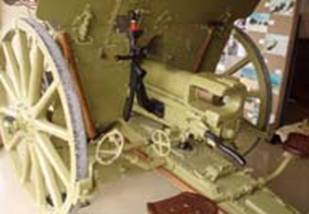 |
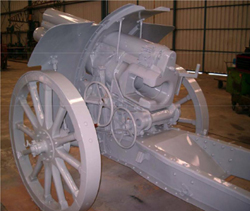 |
The Moonta gun as at the 6th October 2006
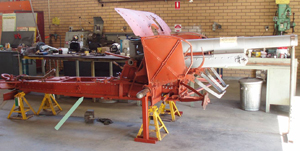
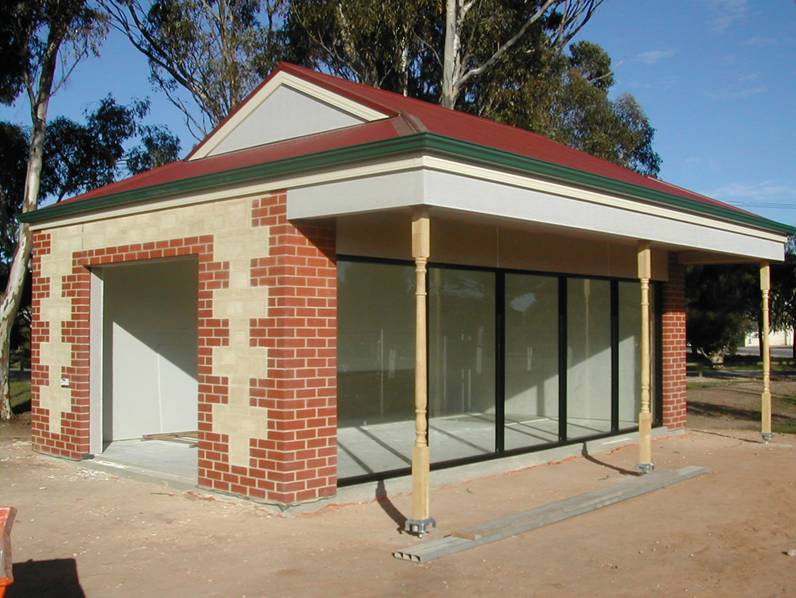 The Warradale work party is planning to have its gun ready for the opening ceremony early in 2007 when it should be “unveiled” in its new purpose built viewing house at Moonta.
The Warradale work party is planning to have its gun ready for the opening ceremony early in 2007 when it should be “unveiled” in its new purpose built viewing house at Moonta.
The final part of this restoration story
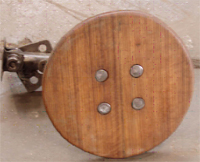 Fortunately with quick trips to the guns at the Keswick museum and searching the Internet we were able to slowly complete its reassembly. However we had to manufacture a whole variety of small and large bits that were too damaged or missing altogether and at this time
6th October we have only one assembly left to make. That of the breech block handle and mechanism to make the block slide in and out. We have made new brake cables and pulleys, a new rear handle for moving the gun, numerous nuts, bolts and various size pins, ball race pressure pads for the traversing mechanism, hold down catches for the container lids, one new hub and lots of metal U pieces for fixing the spoke to the felloes, wooden handles and seats.
Fortunately with quick trips to the guns at the Keswick museum and searching the Internet we were able to slowly complete its reassembly. However we had to manufacture a whole variety of small and large bits that were too damaged or missing altogether and at this time
6th October we have only one assembly left to make. That of the breech block handle and mechanism to make the block slide in and out. We have made new brake cables and pulleys, a new rear handle for moving the gun, numerous nuts, bolts and various size pins, ball race pressure pads for the traversing mechanism, hold down catches for the container lids, one new hub and lots of metal U pieces for fixing the spoke to the felloes, wooden handles and seats.
Many of the little parts that had to be fabricated
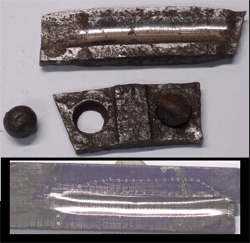 |
 |
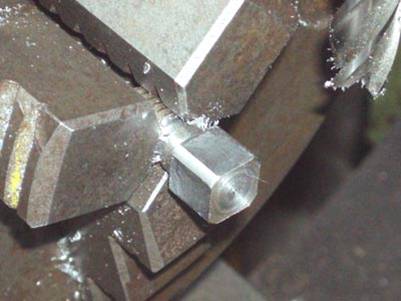 |
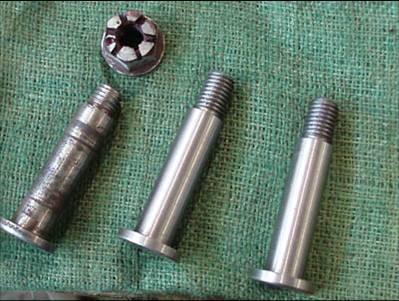 |
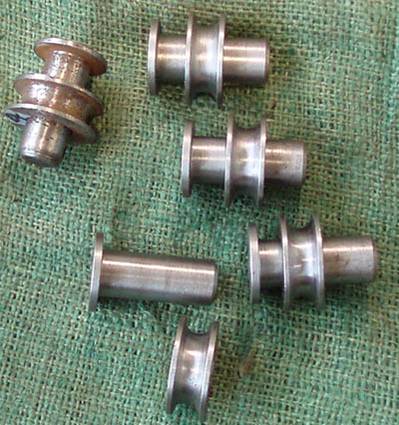 |
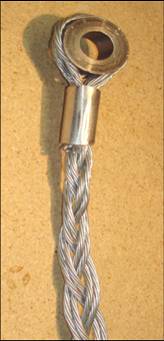 |
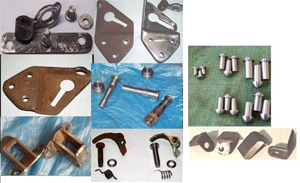 |
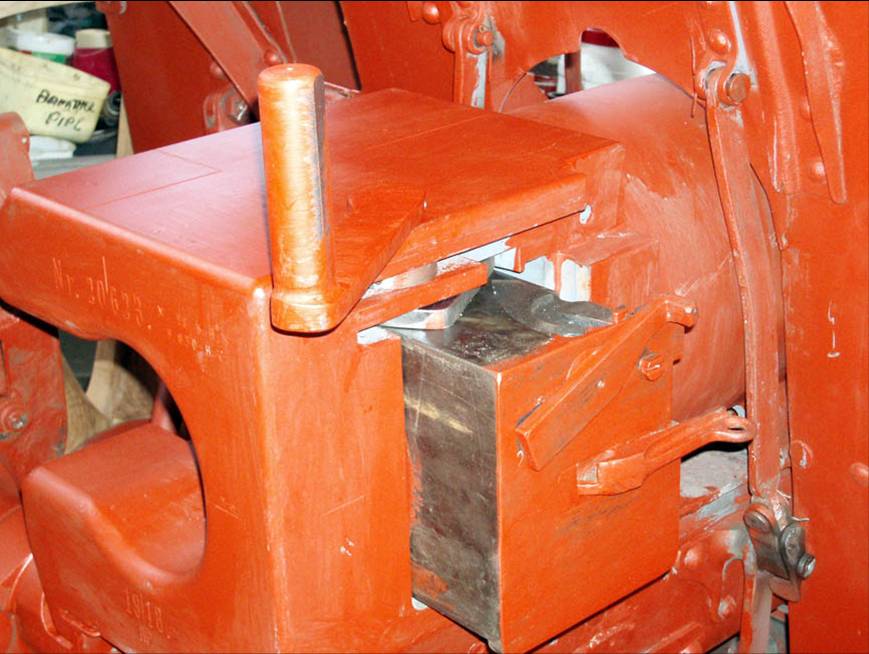 During Oct to December 2006 when we finally finished the restoration so that it could be transported to Moonta to be housed in its new purpose built viewing house we worked flat out to get a working breech block - the wheels completed and the steel tyres fitted, a couple of look alike 105mm shells made and a final paint job. The Breech block mechanism
During Oct to December 2006 when we finally finished the restoration so that it could be transported to Moonta to be housed in its new purpose built viewing house we worked flat out to get a working breech block - the wheels completed and the steel tyres fitted, a couple of look alike 105mm shells made and a final paint job. The Breech block mechanism 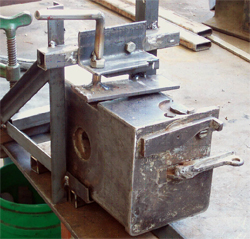 required a jig to be constructed to work out the correct measurements for the mechanism, some extra parts manufactured and fitted.
required a jig to be constructed to work out the correct measurements for the mechanism, some extra parts manufactured and fitted.
Eventually we succeeded and the new parts were put into place on the first of December 06.
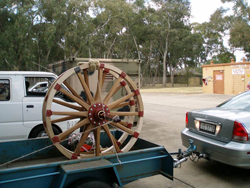
On the 2nd December the new wheels constructed by wheelwright Peter Foster arrived at the workshop. Craig Williams had rolled the tyres for the project at his Pt Adelaide factory.
Shortly afterwards we find out how to fit the steel tyres with an invention worked out by Peter Foster and Robin that saved heat shrinking the tyres.
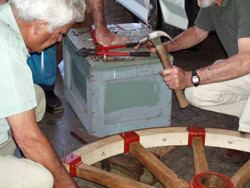 When fitted the steel tyres are then rivetted with steel ¼ “ rivets to the wooden felloes.
When fitted the steel tyres are then rivetted with steel ¼ “ rivets to the wooden felloes.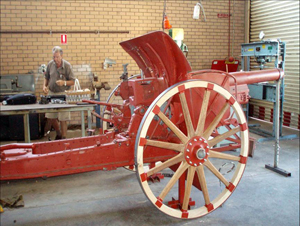 Eventually it all comes together ready for the final painting in Field grey.
Eventually it all comes together ready for the final painting in Field grey.
In no time we had a gun that finally looked the part even though it was still in its undercoat
With the AEME/RAEME association annual general meeting just around the corner the workshop with the President WO1 Grant Kuchel’s blessing arranged an unveiling for all present to inspect. Here’s Dutchy Holland (ex army apprentice and George Robinson (C Comd workshop and auditor) both association Life Members, casting their eagle eyes over our work.
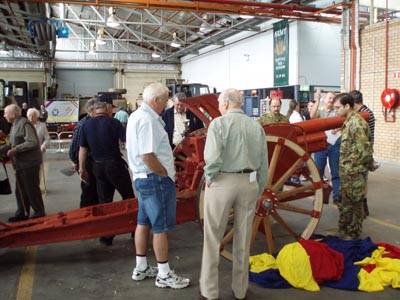
Now for the final paint job.
instead of the using the two pack paint which would have required special OH&S precautions we found a suitable paint and with a new upside down spray gun got to work.
The crew takes a break after the gun’s first coat
and here it is the final finished product.
The only tasks left are to construct a couple of dummy shells - transport the gun to Moonta ready for the big day in February ‘07 when the dedication ceremony will be held at the new building on the outskirts of the entrance to Moonta.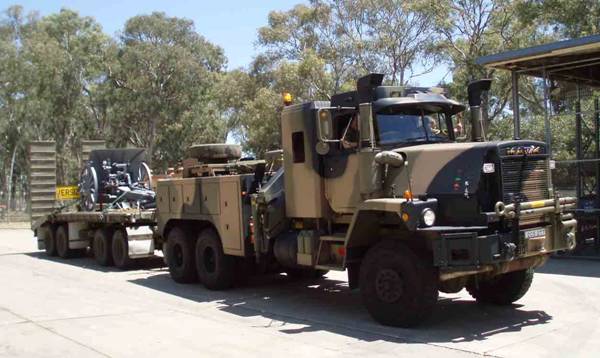 Again 107 Fd Workshops comes to the rescue and recovery mechanic Brett Wilkinson and WO1 Grant Kuckel transport the gun to Moonta
Again 107 Fd Workshops comes to the rescue and recovery mechanic Brett Wilkinson and WO1 Grant Kuckel transport the gun to Moonta
Thursday the 14th December saw the final chapter in the 18 month restoration of the Moonta WW1 German 105mm Howitzer with its return to it’s a new building at the Moonta Tourism Centre courtesy of 107 wksps recovery crew Brett Wilkenson and WO2 Grant Kuchel. The official opening of centre and gun is scheduled for mid February. The happy volunteer project group of mainly ex RAEME tradesmen spent about 3,000 hours over 18 months at the Warradale wksps each Monday. The total project costing approximately $12,000 with the new building about $20,000.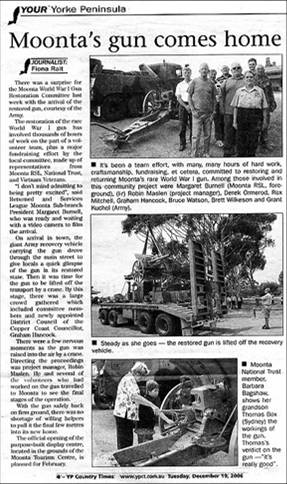 The advertiser reported briefly on the event but the Yorke Peninsula Country Times gave a good write up with several photos.
The advertiser reported briefly on the event but the Yorke Peninsula Country Times gave a good write up with several photos.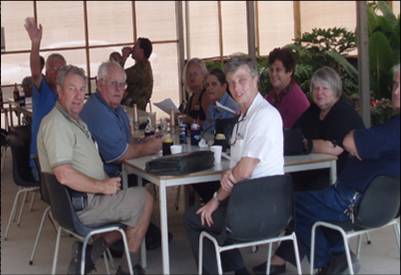 The Viet Vets turned on a BBQ lunch for the committee and those of us from Adelaide before we returned. Most are planning to attend the opening ceremonyin February and we now wonder what to do with our Mondays.
The Viet Vets turned on a BBQ lunch for the committee and those of us from Adelaide before we returned. Most are planning to attend the opening ceremonyin February and we now wonder what to do with our Mondays.
With the gun settled in its new home the final touches were needed to prepare for the dedication ceremony in February. Back in Adelaide Robin got his lathe going once again to turn up some dummy shells for the exhibit whilst the Moonta folks decorated the inside of the memorial with photos and storyboards.
The dummy 105mm German shells constructed by Robin Maslin OAM.
The big day arrives. February 24th 2007. The crowds arrive for the official opening and dedication of what is now a memorial site.
As recorded in the April 2007 RSL newsletter “The Signal”
 “Some 200 people including official guests and members of the Army attended the unveiling and dedica¬tion of the Moonta Memorial Gun on Sat 24 Feb 2007. The Kadina Wallaroo Band provided a background of vintage tunes prior to the official ceremony.
“Some 200 people including official guests and members of the Army attended the unveiling and dedica¬tion of the Moonta Memorial Gun on Sat 24 Feb 2007. The Kadina Wallaroo Band provided a background of vintage tunes prior to the official ceremony.The building was opened by the project patron Mr Jim Harbison OAM who spoke of the home front work of the Moonta community to support its soldiers in WW1. A total of 253 men enlisted from the community, 41 were listed as killed in action.
Mayor Paul Thomas of the District Council of the Copper Coast described the new memorial as a tribute to those who had served their country. He commended all those involved in the project.

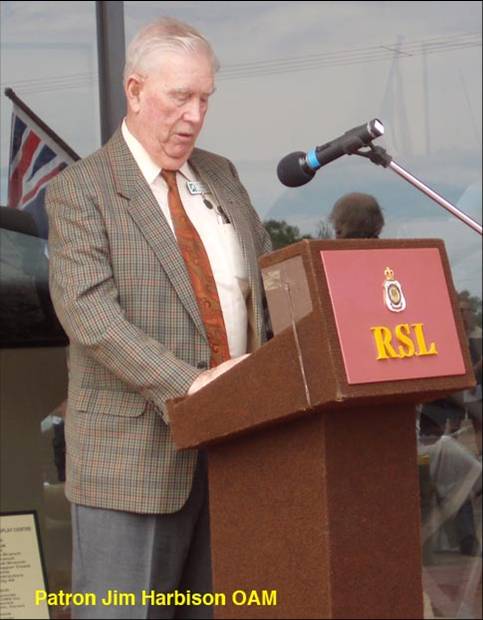 Mr Robin Maslen OAM spoke about the 3000 man hour restoration and how it had attracted worldwide interests, in particular from artillery historians in Germany. The building is internally featured with WW 1 relics and photographs including a photo of battle graves of two soldiers, one from Moonta.
Mr Robin Maslen OAM spoke about the 3000 man hour restoration and how it had attracted worldwide interests, in particular from artillery historians in Germany. The building is internally featured with WW 1 relics and photographs including a photo of battle graves of two soldiers, one from Moonta.
Adding to the ceremony were local flag bearers from the scouts, VVAA members, a 10/27 RSAR catafalque party and the Army's Heavy Recovery Vehicle (HRV)) which returned the gun in December 2006.
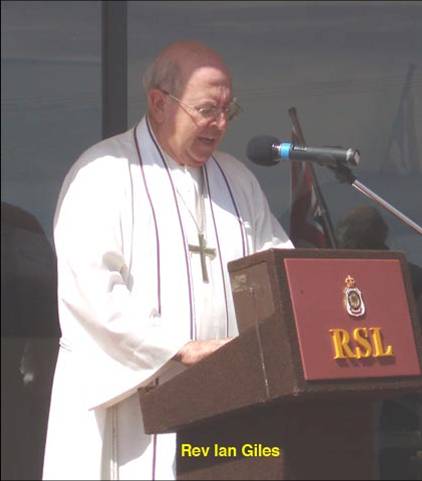 Moonta Uniting Church's Rev Ian Giles gave the blessing and VVAA President Mr Rex Mitchell presented the remembrance part of theproceedings.”
Moonta Uniting Church's Rev Ian Giles gave the blessing and VVAA President Mr Rex Mitchell presented the remembrance part of theproceedings.” Gold silver and Bronze Certificates were presented in Adelaide and Moonta to the many sponsors of the project. Here Robin Maslen presents a Silver certificate to Lt Craig Williams from Williams Fabrications for the heavy metalwork Craig arranged at his worksite.
Gold silver and Bronze Certificates were presented in Adelaide and Moonta to the many sponsors of the project. Here Robin Maslen presents a Silver certificate to Lt Craig Williams from Williams Fabrications for the heavy metalwork Craig arranged at his worksite.
Some approximate costs
The building $20,000
The new trail $5,000
New wheels $4,000
Sundry items $1755
Volunteer hours3000
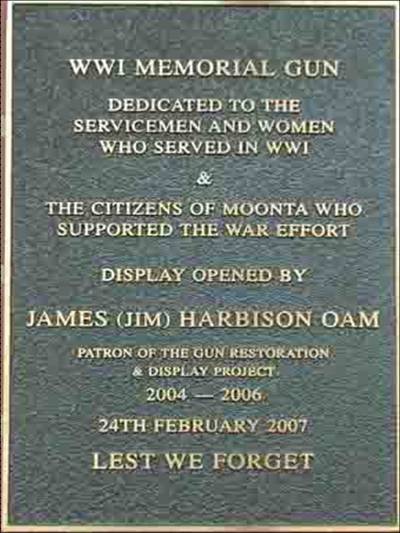 |
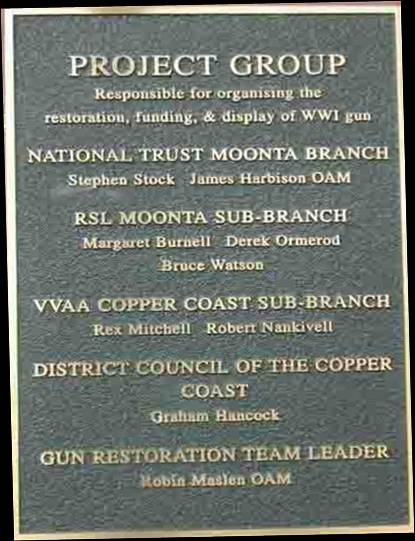 |
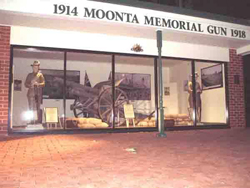 |
